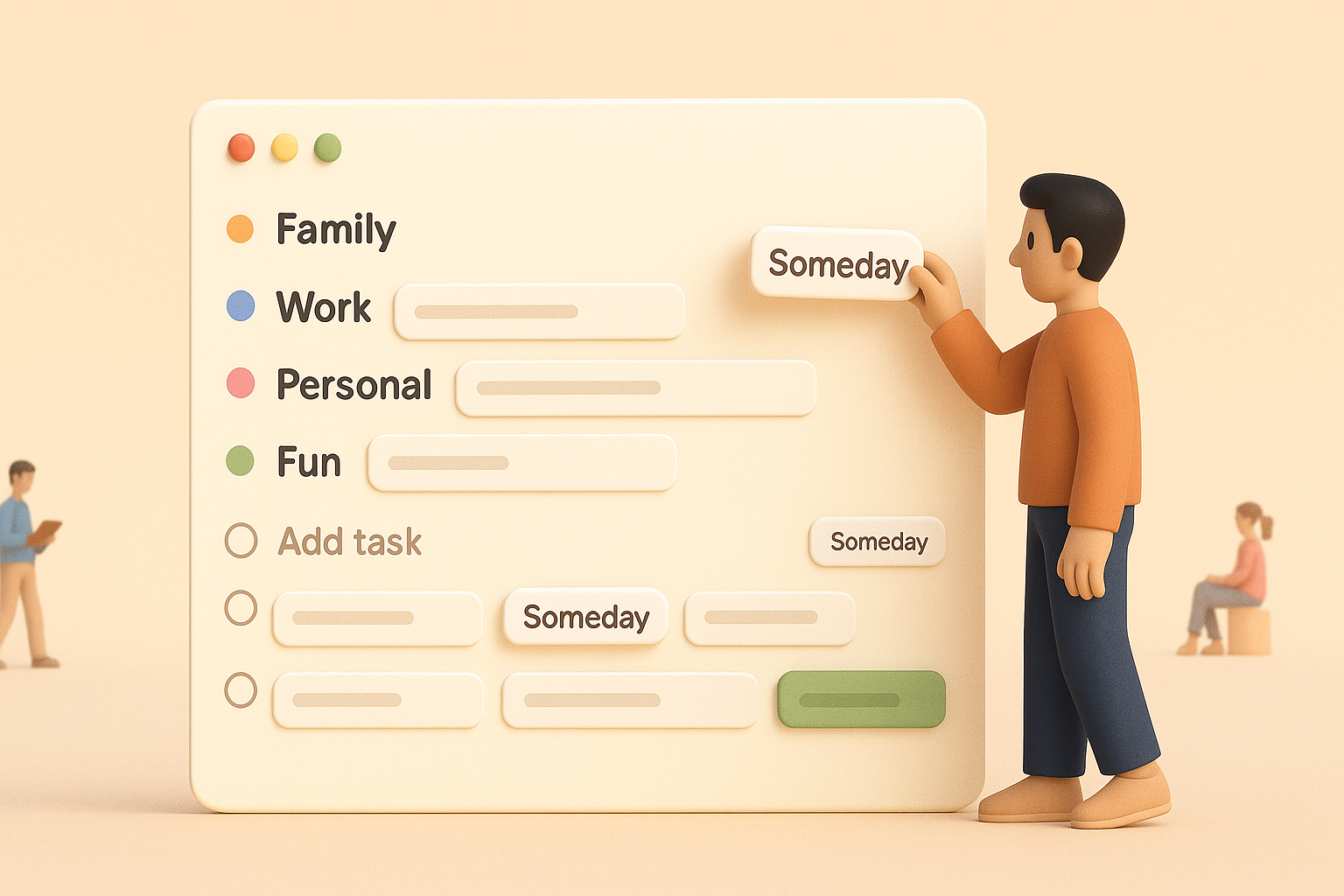Prioritize: The quiet superpower of doing less
Learn a practical system for prioritizing work, family, and personal goals using Todoist, clarity, and a “Someday” list.
I used to think productivity was about squeezing as much as possible into each day. More tasks, more output, more checkboxes ticked. I loved the feeling of being busy. It felt like progress.
But over the years—especially as life, work, and responsibilities piled up—I realized the real challenge wasn’t doing more. It was knowing what to ignore.
This shift didn’t happen overnight. It came from burnout, missed moments, and too many days that felt full but not meaningful. Slowly, I started to see that prioritizing wasn’t just a tactical decision. It was a mindset shift.
If you’ve ever felt stretched thin despite your best efforts, this one's for you.
The myth of getting everything done
Let’s start with a hard truth: you’re never going to get everything done. And trying to is a trap.
Productivity culture celebrates the never-ending to-do list. Hustle. Grind. Check off a dozen things before breakfast. But what often looks like progress is just motion.
I’m a sucker for side projects. If I’m not knee-deep in one, I’m probably brainstorming the next. That burst of excitement can feel like momentum—but without prioritization, it often leads to half-finished ideas and scattered focus.
There was a time when I had five active projects going at once (not counting my day job). The thrill was real, but so was the burnout. That’s when I started asking myself not just "What’s exciting?" but "What’s essential?"
Why clarity beats hustle
Clarity is underrated. When I stopped chasing everything and started choosing one thing at a time, the fog lifted.
Instead of feeling overwhelmed, I began to feel focused. Decisions were easier. Progress felt real, not just performative. And ironically, I started getting more done—because I was doing less of what didn’t matter.
It wasn’t about moving faster. It was about moving intentionally.

Tiny word, big impact
"Prioritize" might be one of the most overlooked verbs in the productivity world. We talk about time management, hacks, systems—but rarely do we stop and ask: what truly matters right now?
I used to feel pressured to say yes to everything. Every opportunity, every idea, every request. But every yes is a no to something else. Once I started saying no more often—and without guilt—I felt lighter.
The word isn’t just about sorting tasks. It’s about creating space for what matters.
How I actually prioritize
Here’s my real, no-fluff method:
I organize everything in my life into four areas: family, work, personal, and fun—in that order. I use Todoist to capture it all. I’ve set up multiple projects, and each one follows a unique color code based on these areas.
- Family: Everything related to home life, parenting, and household responsibilities. This area always comes first.
- Work: Tasks and projects related to my job and professional responsibilities—deadlines, meetings, etc.
- Personal: This includes health, finances, learning, or anything related to personal development and self-care.
- Fun: Creative projects, hobbies, travel planning, or anything that energizes me purely for enjoyment.
My input method? Messy and fast. I jot things down quickly, sometimes half-thoughts, just to get them out of my head. But when it comes to planning my day, I slow down and take extra care.
Every morning, I review and refine. I ask: what needs to happen today? What can wait? And here’s my secret weapon: the "Someday" label. No matter the category, if it’s something I’d love to do but it’s not a priority today, it gets labeled "Someday." It’s my way of saying: yes, this matters. Just not now.

To keep track of those, I’ve set up a filter that gathers all "Someday" tasks into a single view. Whenever I find myself with unexpected downtime, I’ll open that view to see if something can be pulled forward and prioritized. It’s a small system, but it’s helped me take action on things I might have otherwise forgotten.
When you don’t prioritize
For years, I wanted to create a theme for WordPress. It was always in the back of my mind, but I never prioritized it—and, unsurprisingly, I never did it.
Then Ghost came along. I got excited again. I even told myself this time would be different. But once again, I didn’t make a plan, didn’t set aside time, and didn’t prioritize it. And it went nowhere.
A year ago, that changed. I took the excitement and turned it into a plan. I listed the steps, broke them down, and slowly, deliberately worked through them.
Designing, building, and shipping that first Ghost theme took way longer than expected—after all, it was a side project—but I did it. It’s out in the world. And now? I’m building the second one using the exact same method.
A reminder for the overachievers
If you’re the type who tries to do it all, I get it. I’ve been there. Still go there more often than I’d like. But prioritizing isn’t a sign you’re falling behind. It’s the opposite. It’s proof that you’re choosing with intention. That you’re creating a life that aligns with your values, not just your inbox.
So here’s your reminder: You don’t have to do it all. You just have to do what matters.